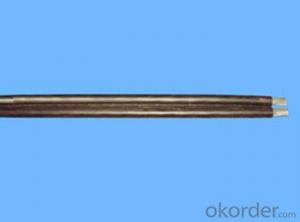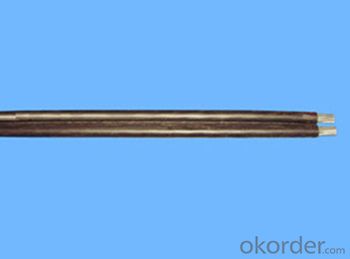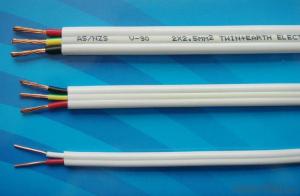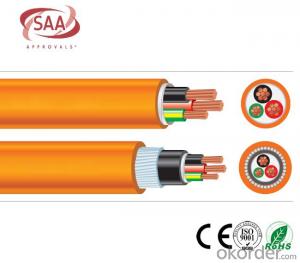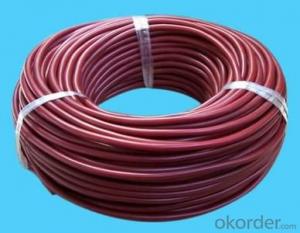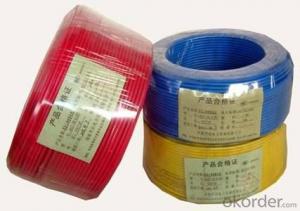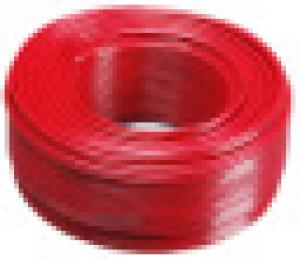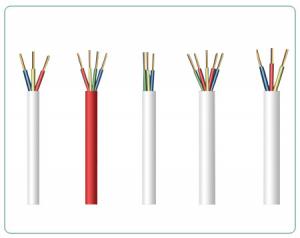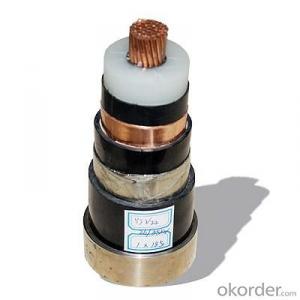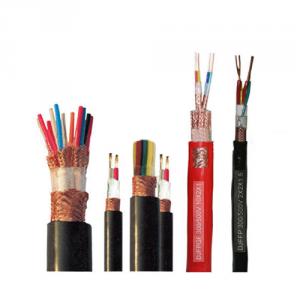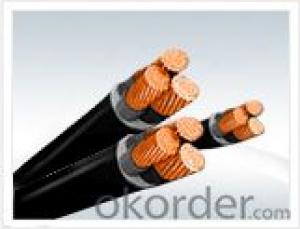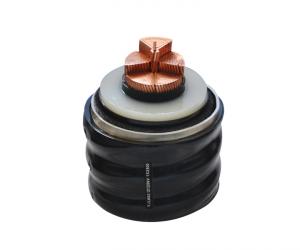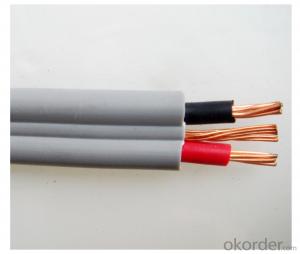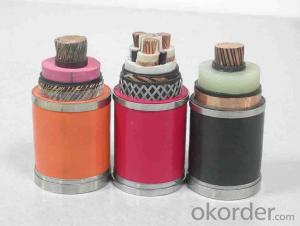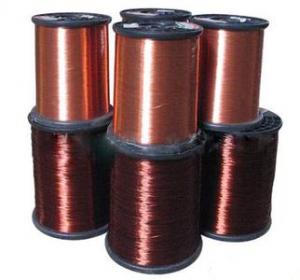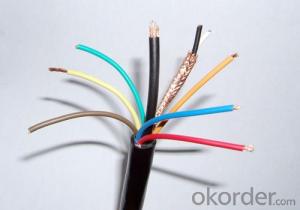Two-core Parallel Cluster Overhead Cable
- Loading Port:
- Qingdao
- Payment Terms:
- TT OR LC
- Min Order Qty:
- 10000 m
- Supply Capability:
- 100000 m/month
OKorder Service Pledge
OKorder Financial Service
You Might Also Like
Two-core Parallel Cluster Overhead Cable
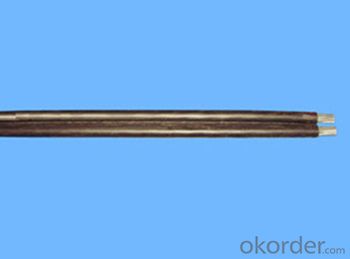
Execution standard
GB/T 12527-2008 Rated voltage up to and including 1 kv overhead insulated cable.
Characteristics
Bundle conductor line loss is low, line loss.suggestions between 5-10%;Saving time and labor for construction is convenient, and reduce the cost of installation;Combination of tensile force of strong, high safety, preventing electricity-stolen, prevent leakage;Low engineering cost, reduce the pole, cross arm and porcelain, to reduce the pole height.
Main purpose and use characteristics
Wire into a cluster shape combination,the anti-large-breaking force doubled than the single line, reducing single-phase disconnection accident. In the wind pressure, frost and other tension between the role of parallel insulation is not under pressure, improve the safety factor, the anti-lightning, anti-tamper, anti-leakage effect was improved. Because of its combination of splitability so that the branch is easy to bridge, variable capacity and convenient combination. According to the zero line identification, the phase sequence identification is clear, to prevent the wrong phase sequence.
Parallel bundle conductor line reduce the tower, cross arm and porcelain pieces, save a lot of metal. As the insulation can reduce the tower height, don’t affected by the trees, buildings and other complex environment, can be completely eliminated Poles and along the wall laying, the project cost is low. In addition, compared with single-line, construction is simple, save time and labor, reduce construction costs. Compared with the conventional overhead bare wire mode parallel cluster wire with low operating costs, long-term benefits of obvious advantages.
Introduction of our company
Our company is a professional China Wire and Cable Manufacturers, mainly supply Aerial bundled cable,House Electric Wire, Insulated Overhead Cable,Aluminium Conductor Steel Reinforced, PVC Control Cables,XLPE Power Cables,BV Electric Wires,Nylon Sheathed Cable,Buried Cable,High Voltage Cable,House Electric Wire,Single Core Flexible Copper Cable,Civil Wire And Cable etc. series of wire and cable products, sincerely welcome everyone to visit.
- Q: Does anyone know what the voltage means on electrical wire sheathing? Some 14AWG wires show 600V and others are 800V.I have a burnt wire that shows 1000V.They are all 14AWG, stranded, copper wire. I just don't know what the voltage rating means. Does the wire support up to that many volts or does the sheath resist heat better the higher the number is?
- It probably means that the insulation on the wire conforms to some standard, and that the cable may LEGALLY be used for permanent wiring in a building at voltages up to whatever number. It's not about heat. When power wiring in a building gets hot, it's strictly because of the amperage that the circuit is carrying, not the voltage. High voltages are a problem because of the tendency to arc. Electric fields are measured in Volts/meter (i.e., the voltage difference between two conductors, divided by the distance between them.) Any given electric insulator will break down and allow current to flow if the field strength is high enough. Cables that are rated for higher voltages either use an insulating material that has a higher dielectric strength (i.e., able to withstand stronger fields), or they use bulkier insulation, so that the distance between the conductors is greater.
- Q: I recently had an electrical estimate done on a house my wife and I just purchased and received their quote via email. On the itemized list of the work we were wanting done, they listed 2000' of 12/2 Romex (way, way more than we would need) for $1200. I can go to nearly any hardware store and find 1000' spools for under $200. The labor rate also seemed pretty high, but I think I could deal with that if they do a decent job. Will an electrician use wiring supplied by the homeowner? Or are they likely to brush me off in order to keep their markup on supplies?Thanks
- Although the price of wire has gone up dramatically, $1200 dollars for 2000 feet is marked up considerably. Unless the price includes the wire-nuts, boxes and covers and Romex clips, and whatever else, (cost per foot). Let's hope you get better quotes from your other bidders. You might ask them to explain the tremendous mark-up! If the price is for the Romex alone and not all the other stuff used to run and terminate the Romex, then you could say that you will be supplying the Romex.
- Q: I have an electrical outlet in my basement family room on a wall made with drywall. I want to 'flip' the box so that it is facing the furnace room. There's no drywall on that side, so I have access to the box and the stud it's nailed to. I just want to cut the power, (check again that the power is off!) pull the nails out, turn the box 180 degrees and renail to the stud. I've got enough slack in the wires.Can I do that?
- I was gonna say sure BUT THEN I AM THINKING to do that you have to undo the wiring to flip it and retighten the nuts back on the same wires. Meaning a pair of pliers is your friend here.if the wires are twisted together and then nutted. Which is a great big hassle. I would be tempted more to draw the power from another outlet in the furnace room and drill a bunch of holes in the 2x4s and run a line from that outlet to the other. or even stealing power from the light and string it down(however in that case the outlet may not work unless the light switch is ON (not the best option but doable and safe) Or, if you can run a separate breaker in the fuse box just for that wire. Or if that outlet is used very little in the family room just run another wire out connected with larger nuts as you are adding another wire to each line and put the box where you want. comfort wise for plugging things in. The only reason all the plugs are 12 inches off the ground is because that is how long the electricians hammer was when he roughed in the boxes.
- Q: I have to make a project for school and it has to be in the shape of a circle on like a cardboard poaster board type thing. I want to put a piece of paper infront of it and somehow hook it up electically so that way if i press a button it will spin to a certian part of the cardboard. Anyone with any ideas on how to do this or know a website that will tell me how to do this?
- To make a circuit that will spin a piece of paper when you push a button isn't that hard. All you need to do is get a cheap button or switch (you have to pick the right kind of switch though, otherwise it's a little more complicated -- I would draw you a diagram, but Y!A doesn't have the tools to do that) and a cheap motor. Take your electrical wires, hook one up to the positive terminal of a battery, take that end and hook it up to one side of the switch, then take another one, hook it up to the other side of the switch, take that end and hook it up to one of the terminals on the motor, then take another wire and connect the other motor terminal to the negative end of the battery. When you flip the switch, it makes the connection and starts spinning the motor. Flip the switch again, and it stops. However, making it spin to a certain part of the cardboard is significantly more complicated, something that you won't learn until college, and even then you'll only learn it if you're working on a degree in engineering or physics (and only maybe physics). It involves either a digital system or a sensor, and it will involve some sort of control system.
- Q: I earlier posted this question and was told not to cover wiring as the wires could overheat, etc. So I was careful to lay out the rolled insulation away from wires.In the recent issue of Popular Mechanics there is a short article on blown insulation. Doesn't that cover just about everything in the attic?Now I am not sure what to do.Can the wires be covered or not?
- cover them,it won't hurt.If you have alot of heat from your wires, they are not fused right or your breaker is too big for the job
- Q: Basically, the long and the short of the story is, I had a gas leak somewhere under my house, so it was cheaper to switch my hot water heater and my stove over from gas to electric, rather than rip up my floors.I have a contractor friend doing the work, due to the fact I can't run the wiring through the attic, what's basically going to be done is run it outside, drill a hole in the wall, and plug it in there. We are using a 30amp 220 v breaker, what gauge wire should we use? The lady at Lowe's say we MUST use 6/2 wire, we MUST and she refused to sell me anything else. I called a cousin of mine who works construction, and he said an 8/2 would work. It has also been suggested that we use 10/2 My contractor friend says he would be comfy using 10/2, but if 8/2 is what I want he will go with it. The Lowe's lady says 10/2 will meltSo do I use an 8/2?Why the patchjob? because the house is going to be torn down in 3 months and a new one builtI dont want my house to burn any ideas?
- Electric Stoves At Lowes
- Q: Cable model ZB and ZR What is the difference
- Cable tray, cable tray, usually made of steel or aluminum alloy, which is the bottom of the ladder called the ladder bridge, the bottom of the plate called the trough bridge, trough bridge is also called the cable tray Width is generally more than 100mm, and occasionally 75-80mm The maximum width is generally no more than 12m Suitable for factories and other cable more and lay the path of the local concentration of choice Cable trench in the ground production of the channel, usually for the brick cement plaster, suitable for less ground equipment, cable and lay the path of the local concentration of the selection, generally with the ground above the cable bridge used together
- Q: electrical house wiring questions : what do we call (whats the technical name) to the wire use in electrical house wiring connect to the switches (buttons) ? one is the hot wire (live wire) the other one is . ?what does happen if we connect a hot (live) wire with neutral wire ?what does happen if we connect a hot (live) wire with earth wire ?what does happen if we connect a hot (live) wire with another hot (live) wire ?what do we call (whats the technical name) to the wire use in electrical house wiring connect to the switches (buttons) ? one is the hot wire (live wire) the other one is . ?what does happen if we connect a hot (live) wire with a half-wire ?
- neutral. You have a short circuit. Hopefully a circuit breaker will pop before you have a fire. same depends. One hot may be out of phase with the other, in which case, see #2. But in any case you will be bypassing the breakers to some extent and creating a hazard. unclear what is a half-wire? .
- Q: How can you tell if a technician drilled a hole into an important electrical wire? Ever since I got satellite installed, the power in my house has been strange, and it is making me nervous. (
- Well, as sorry as I am to say this, The power in my house has been strange, really doesn't give us much to work on. More info would be extremely helpful, like what strange means, and just how it's acting, when it does it's little tricks and then when it straightens out. You can post them as edits, on the bottom of the question page.
- Q: Hi. I would like to add a Maestro Dimmer switch to a three way circuit. My current setup is that I have two switches that control one receptacle. I would like the finished job to have the receptacle be controlled by only the dimmer switch and have the second switch be inoperable.This is what I currently have for my wiring setup.Switch 1 (One wanting to add dimmer to and keep): Red and White wire connected at top of switchWhite connected at bottomTwo black wires connected to each otherSwitch 2 (One wanting to make inoperable):Black connected at topRed and White connected at bottom.Receptacle:White connected at topBlack and White connected at bottomTwo black wires and one white wire connected to each otherI understand somewhat how the two switches work but am baffled at the receptacles wiring. I am no electrician by any means so if someone could explain in simple terms, I would greatly appreciate it!
- Hi There, It is possible the light switch you installed has a high resistance. Try another switch or simply tie the two wires together and see if that makes a difference. Also very possible that you have a bad connection either to/from the switch.or where you connected to the original power feed. Could also be the wire you used to connect the switch is faulty. Try another wire for wiring the switch. From your description it sounds like the lights are wired in series (instead of parallel). If lights are wired in series they will all be dim (but if you turn one off they will all go off). Perhaps the bulbs are too large causing a hudge voltage drop because of too much load on the circuit. If that is the case try only one light at a time and it should be bright. Aslo the wiring would become hot to the touch. Check your wiring again and use a volt meter to find the problem. Hope this gives you some ideas for finding the problem. Al
Send your message to us
Two-core Parallel Cluster Overhead Cable
- Loading Port:
- Qingdao
- Payment Terms:
- TT OR LC
- Min Order Qty:
- 10000 m
- Supply Capability:
- 100000 m/month
OKorder Service Pledge
OKorder Financial Service
Similar products
Hot products
Hot Searches
Related keywords
